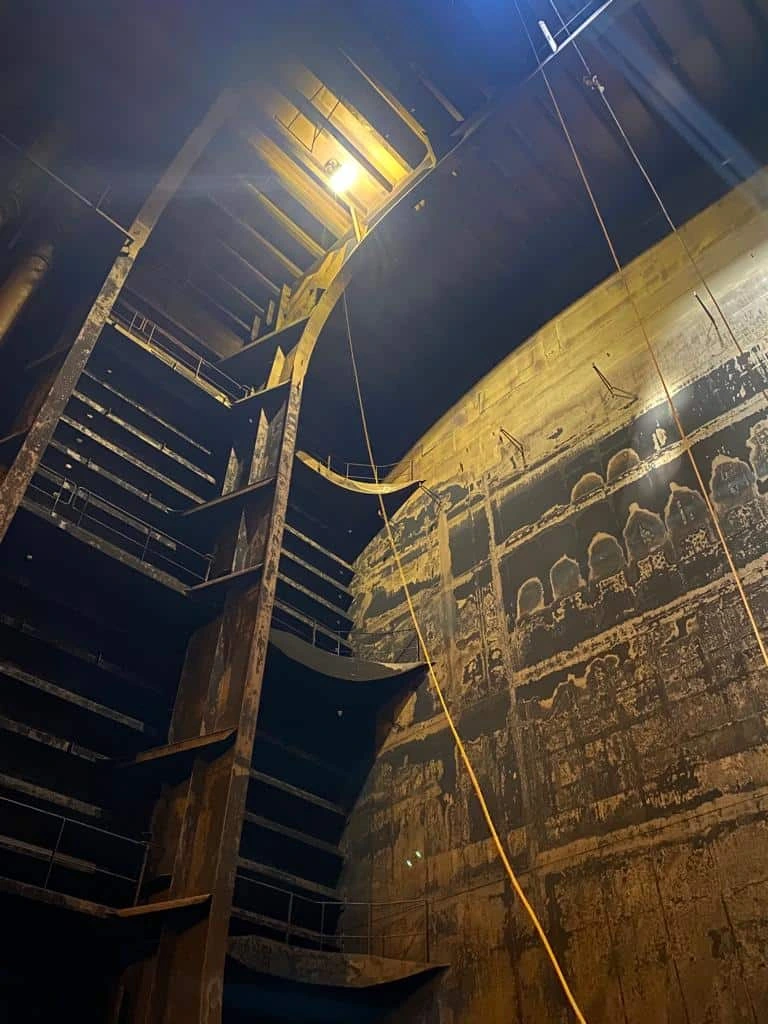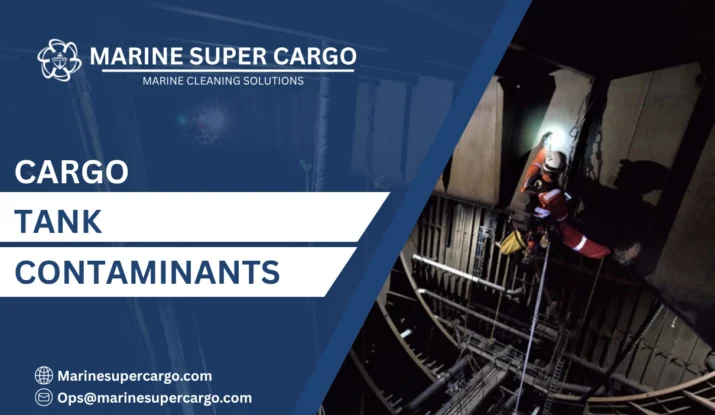Understanding Cargo Tank Contaminants in Marine Operations
Cargo Tank contaminants represent unwanted substances accumulating within cargo tanks compromising cargo quality, vessel safety, and environmental compliance. These tank contaminants range from cargo residues and rust to bacterial growth and chemical deposits. Identifying tank contaminants correctly determines appropriate removal strategies ensuring successful cleaning operations.
Marine Super Cargo specializes in identifying and removing diverse Cargo tank contaminants across all vessel types. Our comprehensive approach addresses tank contaminants while maintaining MARPOL and IMO compliance throughout operations.
Common Petroleum-Based Cargo Tank Contaminants
Crude Oil Sludge
Removing sludge Cargo tank contaminants requires hot water washing at 70-80°C using tank cleaning machines. The heat softens waxy tank contaminants allowing mechanical action to dislodge deposits. Crude oil washing (COW) systems prove particularly effective against these tank contaminants, utilizing cargo itself as cleaning medium per IMO regulations.
Wax Deposits
Wax Cargo tank contaminants form when paraffinic crude oils cool below their cloud points. These tank contaminants create thick coatings on surfaces from centerline to port and starboard extremities. Wax tank contaminants insulate underlying metal potentially hiding corrosion and coating damage beneath deposits.
Asphaltene Residues
Asphaltene Cargo tank contaminants appear as black, sticky deposits resistant to conventional washing. These tank contaminants concentrate in tank corners, frames, and areas with poor circulation. Asphaltene tank contaminants often require chemical cleaning using aromatic solvents breaking down complex molecular structures.
Marine Super Cargo employs specialized chemical treatments for asphaltene tank contaminants, ensuring safe removal without damaging tank coatings or creating additional hazards during operations.
Chemical Cargo Tank Contaminants
Polymerization Products
Polymerization Cargo tank contaminants form when reactive chemicals like styrene or butadiene polymerize within tanks. These tank contaminants create hard, plastic-like coatings extremely resistant to removal. Polymerization tank contaminants may require aggressive chemical treatments or even mechanical abrasion for complete elimination.
Scale and Mineral Deposits
Scale Cargo tank contaminants accumulate from hard water washing, ballast operations, or mineral-bearing cargoes. These tank contaminants appear as white or brown crusts on surfaces, particularly in heating coils and tank bottoms. Scale tank contaminants reduce heat transfer efficiency and provide sites for corrosion initiation.
Sulfur Deposits
Sulfur tank contaminants result from high-sulfur fuel oils or elemental sulfur cargoes. These tank contaminants create yellow deposits throughout tanks requiring specific removal procedures. Sulfur tank contaminants may react with moisture forming corrosive sulfuric acid threatening tank integrity.
Biological Tank Contaminants
Bacterial Growth
Bacterial Cargo tank contaminants develop in tanks carrying vegetable oils, animal fats, or water-contaminated cargoes. These tank contaminants create biofilms on surfaces, consume oxygen, and generate corrosive byproducts. Bacterial tank contaminants produce foul odors and may render subsequent cargoes unmarketable.
Fungal Growth
Fungal tank contaminants appear in tanks with persistent moisture and organic residues. These tank contaminants create visible growth patterns along surfaces and may penetrate coating systems. Fungal tank contaminants prove particularly problematic in ballast tanks and poorly ventilated cargo spaces.
Corrosion and Structural Tank Contaminants
Rust and Oxidation
Remove rust tank contaminants through abrasive blasting for severe cases or chemical rust removers for light oxidation. After removing rust tank contaminants, apply protective coatings preventing recurrence. Follow enclosed space entry protocols when performing extensive rust removal operations.
Coating Breakdown Product
Address coating breakdown tank contaminants through mechanical removal followed by surface preparation and recoating. Identify coating failure causes preventing similar tank contaminants in other spaces.

Removal Methods for Various Tank Contaminants
Mechanical Removal Techniques
Mechanical methods prove effective against most physical tank contaminants. High-pressure water jetting using appropriate cleaning equipment removes sludge, loose scale, and many organic tank contaminants. Adjust pressure between 8-15 bar depending on tank contaminants characteristics and coating sensitivity.
Chemical Treatment Approaches
Always verify chemical compatibility with tank coatings before treating tank contaminants. Improper chemical selection may damage protective systems creating additional problems beyond original tank contaminants.
Combined Treatment Strategies
Marine Super Cargo develops customized treatment plans addressing specific tank contaminants combinations ensuring optimal results while protecting vessel integrity and crew safety.
Preventing Tank Contaminants Accumulation
Regular Maintenance
Prevent tank contaminants through consistent maintenance programs. Schedule regular inspections identifying developing tank contaminants before they become serious problems. Address coating failures promptly preventing tank contaminants from accelerating deterioration.
Proper Cargo Handling
Minimize tank contaminants through correct cargo handling procedures. Maintain appropriate temperatures preventing wax precipitation or polymerization reactions creating tank contaminants. Ensure adequate tank ventilation after discharge preventing moisture-related tank contaminants.
Timely Cleaning
Clean tanks promptly after cargo discharge preventing tank contaminants from hardening or reacting. Fresh residues remove easier than aged tank contaminants that have bonded to surfaces. Establish cleaning schedules preventing problematic tank contaminants accumulation.
Regulatory Considerations
All tank contaminants removal must comply with MARPOL Annex I and MARPOL Annex II depending on cargo types. Never discharge tank contaminants overboard without proper treatment. Retain all tank contaminants and cleaning residues onboard or deliver to approved reception facilities.
5 Essential FAQs About Tank Contaminants Removal
Q1: What are the most difficult tank contaminants to remove?
Polymerized chemicals, hardened asphaltenes, and heavy scale represent the most challenging tank contaminants. These require specialized chemical treatments, extended cleaning times, and sometimes mechanical abrasion for complete tank contaminants removal.
Q2: Can tank contaminants affect cargo quality?
Yes, tank contaminants significantly impact cargo quality through direct contamination, chemical reactions, or odor transfer. Even trace tank contaminants can render high-value cargoes off-specification requiring costly disposal or reprocessing.
Q3: How often should tanks be inspected for tank contaminants?
Inspect tanks for tank contaminants after every cargo discharge and during routine maintenance periods. Annual comprehensive inspections identify developing tank contaminants requiring attention before they escalate into serious operational problems.
Q4: Are there tank contaminants that require special disposal procedures?
Yes, hazardous tank contaminants including heavy metals, toxic chemicals, and reactive substances require special disposal following IMO guidelines and local regulations. Never mix incompatible tank contaminants during disposal operations.
Q5: Can preventing tank contaminants reduce cleaning costs?
Absolutely. Proactive prevention through proper cargo handling, timely cleaning, and regular maintenance significantly reduces tank contaminants accumulation. Prevention costs far less than removing established tank contaminants requiring intensive cleaning operations.


